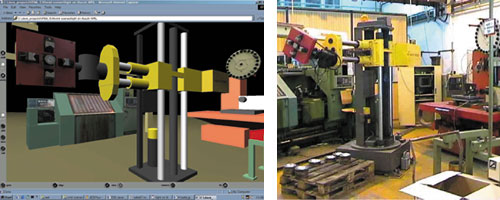
This issue in pdf Subscription Archive: Next issue: October 2005 |
| ||||
Interactive Multimedia for Supporting the Quality of the Productionby George L. Kovács, Géza Haidegger and János Nacsa In the frame of DIGITAL FACTORY, a Hungarian national R&D project on factory automation, researchers are investigating, developing and applying interactive multimedia technologies to assist design, production and test processes. The project is being undertaken at the CIM (Computer Integrated Manufacturing) Research Laboratory of SZTAKI and in the factory partner’s sites. Over the past three years, a generalized software environment (IMUTA) and some use cases have been developed. Within a factory environment, there are several areas in which it is essential that human experts observe, test, control, and understand the details of the production processes. This is the case in both the design and the planning stages, as well as during manufacturing, testing, and verification. The new features of interactive multimedia services raise the level of quality, increase the efficiency, observability and controllability of production, and also allow the customer and the end-user to actively take part in the manufacturing processes. Since tele-presence and interactive multimedia involve the integration of humans, our research work looks at man-machine interaction, and the definition of VMDs (Virtual Manufacturing Devices) devoted to human entities within the production area. A survey on wearable computers and head-mounted monitors was used to analyse current technology with a view to applying computer platforms on the human body.
Significant effort has been devoted to the planning of some pilot demonstrations. We looked for demonstration sites and service-intensive applications that would inspire the hosts and potential customers to implement similar functions. Models were developed for the specific application scenarios in order to derive a generalized framework. Some of these scenarios are the following:
By integrating real-life vision and computer-animated entities, virtual and augmented reality services are offered for specific user applications (see Figure). For that purpose, we developed a distributed simulation and visualization environment for flexible manufacturing systems. It enables users to visualize the results of a simulation of an FMS (flexible manufacturing system) with three-dimensional graphics, or to visualize the actual data of a real system. On the client side, our system uses VRML and Java, so it needs only a Web browser with the appropriate plug-ins to use it. The users can view the scene provided by the simulation system via the Internet, as well as choosing the perspective from which they view it and interacting with it in the simulation phase. The IMUTA concept supports the integration of augmented reality. These developments will make interactive multimedia a more widely accepted tool not only in simulation and experimentation, but in real factory applications. This will, however, require further organization and management. Link: Please contact: | ||||


